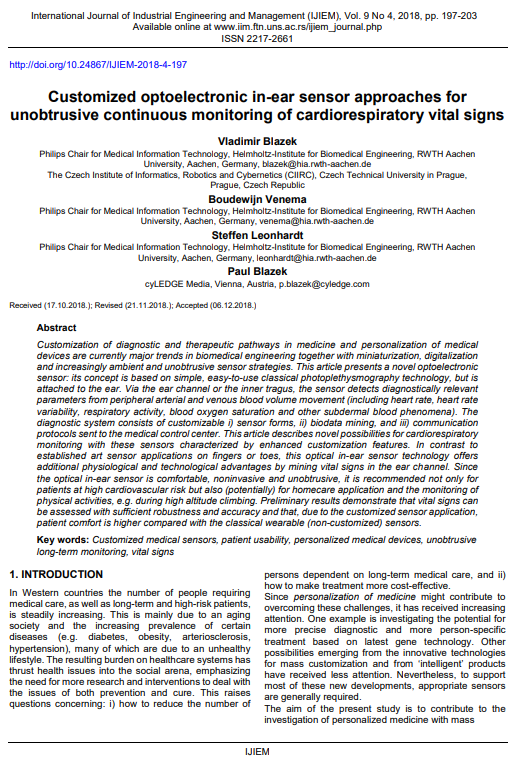Customized Optoelectronic In-Earsensor Approaches for Unobtrusive Continuous Monitoring of Cardiorespiratory Vital Signs

Published 2018-12-30
abstract views: 48 // FULL TEXT ARTICLE (PDF): 0
Keywords
- Customized medical sensors,
- patient usability,
- personalized medical devices,
- unobtrusive long-term monitoring,
- vital signs
How to Cite
Copyright (c) 2023 International Journal of Industrial Engineering and Management

This work is licensed under a Creative Commons Attribution 4.0 International License.
Abstract
Customization ofdiagnostic and therapeutic pathways in medicine and personalization ofmedical devicesare currently major trends in biomedical engineeringtogether with miniaturization, digitalization and increasingly ambient and unobtrusive sensor strategies.This article presents anovel optoelectronic sensor:itsconcept is based on simple,easy-to-use classical photoplethysmography technology,but is attached to the ear. Via the ear channel or the inner tragus, the sensor detectsdiagnostically relevant parametersfrom peripheral arterial and venous blood volume movement(including heart rate, heart rate variability, respiratory activity, blood oxygen saturation and other subdermalblood phenomena).The diagnostic system consists of customizable i) sensor forms, ii) biodata mining,and iii) communication protocols sent to the medical control center. This article describesnovel possibilities forcardiorespiratory monitoring with these sensorscharacterized by enhanced customization features. In contrast to established art sensor applicationson fingers or toes,this optical in-earsensor technology offers additional physiological and technological advantages by mining vital signs in the ear channel. Since the optical in-earsensor is comfortable, noninvasive and unobtrusive,it is recommended not only for patients at high cardiovascular riskbut also (potentially) for homecare application and the monitoring of physical activities,e.g. duringhigh altitude climbing.Preliminary results demonstrate that vital signs canbe assessed with sufficient robustness and accuracy and that,due to the customized sensor application,patient comfort is higher compared with the classical wearable (non-customized) sensors.
Article history: Received (17.10.2018); Revised (21.11.2018); Accepted (06.12.2018)

